Click button for detailed article about each place.
NICE
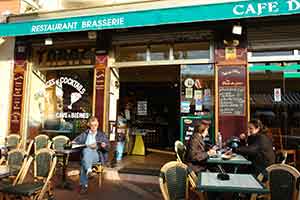
The south coast of France along the sunny Mediterranean Sea is one of the world's most beautiful destinations, dotted with colorful seaside towns and inland villages perfect for discovering on foot. Artists, movie stars, jet-setters, backpackers, billionaires and millions of ordinary tourists are drawn here by the sweet appeal of this paradise-by-the-sea.
Nestled in southeastern Provence, this 50-mile stretch of Mediterranean coast is called the Côte d'Azur by Europeans, or the French Riviera by Americans. The lovely towns along this shore can be easily visited without the hassles of driving a rented car, thanks to the excellent network of trains and public buses that connect all the main places. Compact town centers offer ideal walking conditions for viewing many fine sights. If time permits, you could happily spend a week or two by simply slowing down the pace, but three days will provide a satisfying visit, with our careful planning. This section explains exactly how we get around and what sights we shall see. The environs are beautiful and our excellent hotel accommodation makes Nice an admirable center from which to explore the Côte d'Azur in both directions.
Nice is a year-round destination, especially busy from May through August when it is warm and crowded, but just as lovely during the spring and fall, cooler and with fewer visitors. The most popular season is summertime when the beaches are packed with sun-worshipping nubile bods, but we suggest you visit during the off-season instead to avoid the crowds and enjoy the cooler weather. Europeans crave that brief summer sunshine -- so work around their schedule and come in late September when the weather is still wonderful with daytime temperatures in the 50-60s, no crowds in sight, and cheaper hotel and airline prices. With a population of about 1 million it's the 2nd largest French city along the shores of the Mediterranean after Marseille. During summer the towns throughout this region will be very crowded, creating an entirely different experience that we do not recommend.
DAY ONE: NICE
-04.jpg)
This largest city along the Côte d'Azur makes an ideal home-base for seeing all the sights: it is one of the most beautiful places; offers a large number restaurants in all ranges; and is centrally located with excellent rail and bus services. The nearby towns of Cannes, Antibes, Vence, St-Paul-de-Vence, Grasse, and the neighboring nation of Monaco, all easily reached within one hour by train or bus from Nice. We arrive by train at the great, old-fashioned train station, and take taxis to our hotel down by the seaside, the best location.
We stay three days in Nice, the queen of the Riviera, because it is so beautiful and also makes a very good home base for exploring this scenic and picturesque region. Nice is just 30 minutes by train from Cannes and Antibes. We will lead you through those towns as well and take you to the smaller villages of Vence and St Paul, and then to Monaco, world’s smallest and richest country with its casino at Monte Carlo. There are many wonderful sights to see in Nice and also in the nearby towns along the Côte d'Azur.
Nice is divided into numerous neighborhoods, but the visitor can focus on four main areas on this first day: the beachfront, Old Town, modern shopping district and main hotel section. The most famous image of Nice is the broad, ocean-front boulevard, Promenade des Anglais, framed with the blue Mediterranean along one side and a long row of elegant hotels on the other.
ARRIVAL
-04.jpg)
Your first day itinerary can include the beachfront, the old town, the modern shopping district and the main hotel section. Perhaps the first thing you’ll want to do after getting settled at your hotel is head down to the waterfront to the beautiful beach, admire the views, enjoy a stroll and snap some pictures.
The long and broad beach is especially lovely on a sunny day. The beach itself is lined with hotels and apartment buildings for about 2 miles -- it's not exactly a fine sand beach, but more of a pebble beach. The most famous image of Nice is that broad oceanfront boulevard, framed with the blue Mediterranean along one side, the long row of elegant hotels and apartments on the other, so one of your highlight moments is just sit on a bench gazing out across the beach to the beautiful blue sea.
-04.jpg)
The water is quite clean and you will probably see people fishing from the shore. If you are here in the off-season, nobody will be swimming or even sunbathing, but just enjoying the sunshine and the sights all around.
One of the greatest waterfront strolls to be found anywhere is this Promenade des Anglais. It's a broad, pedestrian, paved area running right alongside the beach with beautiful views out to the blue sea on one side and the grand old buildings lining the street on the other. It's been the main center of attraction in Nice for the past 150 years ever since visitors have been streaming in.
It was first started back in the 1860s, 1870s when Nice began to be attracting visitors from the north of Europe and it has continued as one of the great walkways of Europe. Walk along that palm-fringed, waterfront promenade, passing some of the deluxe hotels, including the Negresco, the supreme, 5-star deluxe landmark, and famous for its Le Chantecler restaurant, earning two stars in the Michelin Guide. There are also moderately-priced lodgings, about 100 good choices, in the main hotel section between the beach and the train station, an area about 20 blocks along the shore and 10 blocks inland, with Boulevard Victor Hugo running through the center.
.jpg)
At the East End the Promenade changes name to Quai des États-Unis, the United States of America. Across the street you’ll also notice the backside of the opera house, a great old theater, the Opera Nice Côte d'Azur. The first opera here opened in 1776 and this building was created a century later. A block further notice the lovely memorial in Greek revival style, built to thank the United States for their help back in 1918 ending World War I.
Just behind that memorial, a block inland from the water, you'll find the Cours Saleya, one of the great outdoor food markets and picturesque spots of Europe. This broad plaza features fresh produce and flowers in the many stalls, some of which are open into the early evening, except on Mondays when it becomes a market for antiques and some other used goods peddled by colorful vendors. They've got a whole variety of furniture, there's clothing, jewelry, the usual, the bric-a-brac, the old books, antiques, electrical items, you've got old cameras. While you might not buy anything it's fun just to look around, enjoy the people and check out the hundreds and thousands of items on sale.
The Cours Saleya is surrounded by inviting cafés that are open from morning till night, so you can stop for a break if you like or just take a walk on by and check it out for later. You might even find something here that you want to purchase -- it could be something authentic from the region.

There are always the flowers to enjoy, even if you are merely looking and sniffing. The flower shops are one of the most interesting features of Nice -- bouquets composed of the most exquisite flowers of every size and description from tiny buttonholed sprays to masses of blossoms 2 feet in diameter. Flowers are so important to Provence, not just for decoration at home, but as industrial agriculture because of the perfume industry. Grasse is the capital of fragrance, as you can discover a few days later in this visit.
Well of course it's a food market so there are lots of other eating options here at the Cours. You'll find bread and cheese and of course always lots of fresh fruits, ingredients for an instant picnic.
It's nice to take a little time to sit down and relax at a café for a drink and a rest and some people-watching. Instead of being in a constant rush while you're traveling stop and take a look at the passing scene. Chocolate lovers should look for the famous store Maison Auer in its landmark Belle Époque building at the West End. This chocolatier has thrived since 1820. Of course olives are essential to the cuisine of Provence so it's only natural you're going to find a shop selling olives and olive oil and balsamic vinegars of all kinds - a great variety here.
You would really enjoy a taste of socca, one of the great foods of the South of France and Chez Therese is the most famous place to find it. Socca is like a crepe, a flatbread. This humble bite is one of the specialties of Provence, but oh so delicious in its many variations. Also found in the Ligurian area of Italy where it is called farinata, this simple food is made from chickpea flour and olive oil. After being formed into a flat cake and cooked on a cast iron pan more than a meter in diameter, the socca is seasoned generously with black pepper and eaten while hot with the fingers. Yummm.
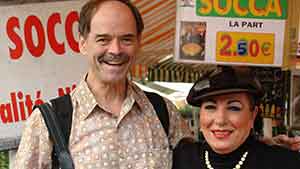
Of course olives are essential to the cuisine of Provence so it's only natural you're going to find a shop selling olives and olive oil and balsamic vinegar's of all kinds -- a great variety here.
France is a wine country. There's no question that France produces the best wine in the world. They also produce casual drinkable wines, and in the case of the Beaujolais nouveau it's an annual event on the third Thursday of November every year -- the official release of Beaujolais nouveau, a fresh young wine. It is in the bottle eight weeks after it's been harvested so it's very young and it's kind about pink purple color.
The church facing the Cours is the Chapel of the Misericordia, or the Chapel of Mercy. It's built in the Italian Baroque style constructed between 1750 and 1770 by some architects from Torino nearby. It has a very elaborate Baroque interior.
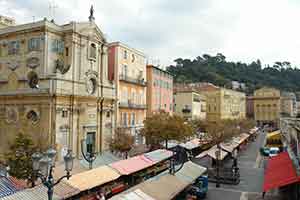
You can even buy some original paintings directly from the artist depicting the scenes all around you that will go nicely with the photographs that you’re taking. The most famous artist who lived in Nice, Henri Matisse, lived right here at the Cours in the yellow building at the far end of the plaza. He had a great view out his window that he depicted in many paintings. He moved to a larger mansion now converted to the Matisse Museum, described later. Matisse lived in and around Nice for his last 37 years about which he said "I couldn't believe how lucky I was."
OLD TOWN
Just inland from the Cours Saleya you'll find the Old Town of Nice, a major highlight of the city. Visitors love wandering through these narrow pedestrian lanes lined with historic buildings, shops, restaurants, bars, small plazas with fountains and statues, a church here and there -- it's just a great spot to explore and hang out.
The Old Town of Nice has a special charm you do not find in the rest of the city, so you really want to focus much of your time in this fascinating pedestrian zone on the east end of the waterfront between Quai des États-Unis and Boulevard Jean Jaures. Take a detailed look at the Old Town this first day but be sure to walk through again in the early evening when it is most beguiling. This compact pedestrian zone is small enough you can explore by simply wandering, using the main lanes as jump-off points of reference. While strolling look up and down the side alleys and see what catches your eye, turning left or right as the fancy catches you. You can always use a map or street signs up on the buildings as your directional aids to help you get around here but don't worry about getting lost, you will find your way very easily. If lost, what better excuse could you have to strike up a conversation with a local than asking for directions?
The old town of Nice is something very special -- not so much because of historic monuments or great churches or important single buildings, but just the total atmosphere, the environment, the simple walking lanes, the shops and the people. There are actual locals living here, there are kids out playing, the residents are upstairs looking down from their windows and you really get a feeling of community here, of authenticity, especially in the off-season when it's not too crowded with tourists walking through the lanes -- that helps quite a bit.
Called the "Vieux Nice," the Old Town is home to art galleries, little shops, small restaurants, bars and cafes, making it the perfect spot for strolling. In the off-season the character of Vieux Nice is quite peaceful with not many people and no cars, but in the summer it gets very crowded.
.jpg)
The old town maze of narrow lanes occupies a triangular slice about 300 yards long on each side, so this old town is not a huge area that you're going get lost in, but you'd be surprised at how big it seems as you're walking around because of all the little lanes and alleys that somehow connect and interconnect. There are several main lanes which curve around the perimeter encircling the Old Town, with many smaller lanes and plazas criss-crossing throughout the center, so you can walk all around the periphery while feeling free to wander back and forth in the little side lanes. You might end up walking around in circles a little bit, part of the fun, which makes it seem much bigger than it really is.
Our walking tours will lead you on easy routes right through and around the heart of the old town, pointing out a nice way to navigate through this labyrinth navigating in and around the main highlights. You could do this in one hour if that's all the time you’ve got, or better yet, spend a day or two exploring the nooks and crannies.
There is a beauty in this old town of just simply walking, so it really deserves to be front and center when you come to visit Nice. These narrow old lanes are often overlooked in guidebooks or historical memoirs or even dismissed as a place that's dark, narrow and congested, but it's what makes the city so very special, along with the beachfront of course, that marvelous white broad beach and the promenade down by the Mediterranean Sea. The modern downtown certainly is lovely and we’ll lead you there as well in the visit, but these little back lanes and waterfront are what make Nice something special.
As you enter the old town from the end of the Cours Saleya one of the first streets you'll come to is the very atmospheric Rue de la Poissonnerie, home to the typical shops and restaurants that you'll find throughout the old town. Continue along one of the main lanes, Rue Droite, lined with cute shops and art galleries. There are some fine typical examples of staircase streets that branch off from Rue Droite, such as Rue Molinaro, along with several more parallel lanes that go up the hill. They are regular streets down on the flatland, and when you go up higher and steeper there are no cars, a few scooters perhaps, motorcycles and bicycles, but largely you enter a pedestrian zone on the lower hillside of Nice down below the Château, a typical residential neighborhood. It's interesting to see here the working population at home - comfortable affordable housing in the middle of the city. Another steep lane, Rue du Château, and several others. These lanes are among the most picturesque streets in town but don't worry, you don't have to climb them.
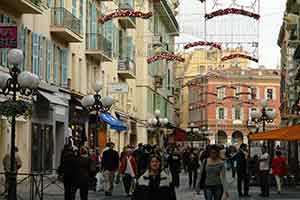
And if you don't feel like walking you can take the little tourist mini-train on a route that will bring you through the Old Town and then up onto the hill for a view, but of course you know, walking is better.
Most of the shops in the old town are independent and unique. You've got boutiques, crafts, arts, all kinds of great browsing to do -- so different than modern shopping malls.
You'll find souvenir shops with the typical Provençal items, especially the colorful fabrics and the pottery. There's also plenty of food in the convenience stores, or in the cookie boutique.
We especially enjoyed the local cuisine of the casual restaurant, Créperie Breton. They specialize in crépes and socca and salads, and that's really all you need for a very nice lunch.
And the friendly couple running the place really made us feel welcome. They are the owners -- the cook, waitress and the food was delicious. You might be surprised at the variety of crépes on offer and that socca.
You will be wandering this way and that as you meander through the old town but you'll come back to Rue Droite which goes like a straight line through the middle of the old town. It's a good axis to get your bearings, to go out to the left, go to the right and then come back to this central spine.
The Palais Lascaris, at 15 rue Droite, is the largest civil Baroque building in the old town and the region. It perpetuates the reputation of Charles Emmanuel the second, who was Duke of Savoy, considered one of the principal families of Nice nobility of the 17th century. The palace was influenced by the Genoese Baroque and unites a set of 17th-century embellishments and some changes from the 18th century.
Le Palais Lascaris encloses two small courtyards on which arched bays open up a monumental staircase. The lobby is free and open to the public, certainly worth a look at the attractive wall and ceiling frescoes. If you like to go inside the small museum there is an admission charge and you will find exhibits of 17th and 18th century arts and crafts featuring ceramics, decorative and religious arts and furniture from the Baroque era as well as an exceptional collection of ancient musical instruments.
Along the lane and throughout town you'll find souvenir shops with the typical Provençal items, especially the colorful fabrics and the pottery. There are also lots of temptations in the small food stores -- go for the cookies. A few hundred years ago this was already a very old part of town and had become somewhat rundown and dilapidated and it's really just in recent decades it has come back to life again.
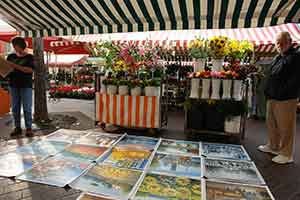
At the end of Droite you run into the main lane that runs along the north edge of the old town. Curiously, it changes names five times in less than 1 mile: Marché, Boucherie, Centrale, Collet, François, Pairolière. This is perhaps the best pedestrian route of the Old Town. It just wanderers, meanders, not quite straight -- there's a little bit of a curve here and there as it changes names. You'll see cafés, tourist shops, local shops and people out walking along it, especially at twilight -- the perfect time. These shops are open in the evening with plenty of people out. This of course is a very safe neighborhood, a family kind of place. Of course there are no cars allowed in these narrow pedestrian lanes but you'll run into the odd moped, so keep your ears open.
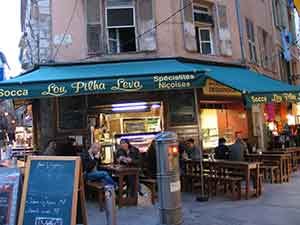
As you leave the end of Rue Droite turn left on Rue du Collet which soon changes name to Rue de la Boucherie where it forms a delightful intersection at Place Centrale. Each city has essential focal points where the action happens, and this corner, fittingly called Place Centrale, is a perfect example. Appreciate this special junction for a moment, where several pedestrian lanes come together: Rue Droite, Rue Sainte and Rue Françoise all merging in this wonderful little spot surrounded by cafés, shops and people. This is one of those moments where it's nice to stop for several minutes and simply look around watching the endless parade of people passing by, action at the busy sidewalk restaurants, pastel color of the attractive buildings with the residences above, sounds of people talking, stimulating smells wafting out from kitchens and vibrant life all around. Better yet, drop anchor at the sidewalk cafe for a drink or snack and observe the passing scene.
Place Central is a simple affair -- you’ve got a casual restaurant that sells socca and other Niçoise specialties. There’s a café on the other side, there's a little food market here, you can buy some gadgets and gizmos. The fresh produce market is fun. You can shop for some clothing, all in an arm's reach from this central place. It is a vortex where people gather, an outdoor living room of the old town. It's not a particular highlight you’re going to find posted high in ordinary guidebooks, but this is truly one of those special little places.
Any of the five lanes leading out from this point are worth a stroll, but to continue along the suggested route, walk along Rue de la Boucherie, which changes name again to Rue du Marche, soon reaching the main gathering place, Place de Palais, which retains an Italian feeling that once permeated the town. Up until 100 years ago Nice really was more Italy than France, controlled by the Dukes of Savoy of Northern Italy, and while joined to France in 1860, still displays a strong cultural blend in features such as its unique language, le Niçoise or Nissart, a hybrid of French and Italian which cannot be understood by anyone outside of Provence.
Place du Palais enjoys a typical European atmosphere -- fountains in the middle, several sidewalk restaurants and a big chunk of neoclassical architecture looming large on one side, the Palais de Justice. This courthouse square might seem an unlikely social hub, but it's one of the largest open areas in the Old Town and so naturally you'll find many people here, especially in the evening. It's got French sidewalk restaurant serving crépes and wine, and the neoclassical courthouse looking like a Greek temple. It is definitely worth visiting in the daytime when it's quite busy, and then again in the evening when it's even more busy.
Several interesting streets can lead you out from here on further adventures, such as to Place Rossetti, the other main gathering place in the Old Town, easily reached in seven short blocks along Rue de la Préfecture and Rue Sainte Réparate.

Place Rossetti is accented by its Italian-styled Baroque church, Cathédrale Sainte-Réparate, the cathedral of Nice. It's beautiful with brilliant colors in the Baroque styles. It was built during the second half of the 17th century, a time when this area was more Italian than French. The interior of the church has 10 chapels with a floor plan in the Latin cross that was based somewhat on the church of Santa Susana in Rome. Typical of the Italian Baroque, it's highly decorated with many paintings and architectural flourishes. At twilight the beauty of the building is at its best. In fact anywhere you go at twilight it's a wonderful experience.
This plaza is a popular gathering spot surrounded by bars and restaurants with Italian-style architecture as you find throughout the old town. Because of its central location with so many roads going through you'll probably return here a few times during your visit. Do come back in the evening when the action picks up.
From here you would enjoy a stroll along its namesake, Rue Rosetti, another picturesque lane which steeply rises up the hillside changing character as it goes. At the far end some its sidewalks are staircases with a narrow one-lane road down the middle, lined with apartments and local folks hanging out.
These little streets are among the most interesting walking routes that you'll find anywhere in the south of France. This neighborhood is quite lively because people live here. Most of the upper floors in the old town are residential apartments with full-time residence and that gives it a real home quality. You see the life in the streets here is what modern major urban centers are trying to re-create, trying to strive for -- real streets with real people living out their daily lives, and it's on a human scale because you don't have skyscrapers, you don't have massive structures all around. It is people and their homes and their playgrounds in the street.

As you walk along through the narrow pedestrian lanes there is not really a lot of history or analysis to bother with -- it’s mostly about visuals, the enjoyment of seeing shops, the people, the old buildings, the architecture. Several hundred years ago nearly everybody lived in the old town -- that really was Nice itself. There was a little bit of population up on the hill, a little bit around the bend over at the harbor, a few houses scattered of course up in the hillsides in the interior but one could imagine 90% of the population was clustered right here in what is now the old town a couple of hundred years ago. A few hundred years ago this was already a very old part of town and had become somewhat rundown and dilapidated and it's really just in the past century it's come back to life again. (More history at the end of this chapter).
Note that our route occasionally has you walking in circles because that is the reality of navigating through this old town and part of the fun because you are seeing the same places over again from different angles at various times of the day and night, which makes this little zone seem much bigger than it really is.
Early evening is a magical time to be out strolling of course with the twilight and the shop lights -- very safe, very friendly, a lovely place to stroll. At dusk you’ll enjoy the colorful combination of light from the evening sky with the street lamps and the ambient glow from the shop windows -- it mixes in a beautiful way to produce those saturated dark blue skies and orange lights which look lovely and make special photos -- sometimes digital cameras pick up richer deep colors than the eye can notice.
.jpg)
It's very safe walking around in the evening in this old town area, especially on the main lanes where you've got the shops, you've got the people. Everybody's out and about, as long as you're out there a reasonable hour from twilight right on up through the end of dinner. Here in the old town you've got that ambient lighting on the buildings and shops. You would find it rewarding to visit the same places daytime and nighttime -- it gives you that complete experience.
In the evening the old town is alive, the shops stay open until nine PM, some of them even later, especially in this tourist area. Of course the hour of sunset varies considerably during the year, for example in December it gets dark at 5 PM and in the middle of June it gets dark at 9:30 PM. Either way you're sure to enjoy an evening stroll. Many shops do close in the afternoon for siesta, after all we are in the south of Europe and they follow that traditional custom, so it might not be best to stroll here between 1 PM and 3 PM -- a lot of the shutters are down, but they'll be reopening at three or 4 o'clock. You'll find that a majority of the shops do stay open throughout the day.
And there are plenty of art galleries along the way. You might even get a chance to meet the artist -- usually they’re inside the shop and maybe doing a little bit of painting. It is like The Streetside Museum of Contemporary Art. This is art that's very much up to date -- it was just created yesterday.
-04.jpg)
This ambience shares a lot of the Italian heritage of Nice, after all remember up until 100 years ago this really was more Italy than France and so it has that wonderful Italian character.
Perhaps there will be time to continue your explorations of Nice this first afternoon, or more likely tomorrow, with a visit to one or two of the town’s fine museums, if you are an art fan. There's a wonderful Matisse Museum in a park slightly away from the center of town, which you can reach by public bus or taxi. Matisse lived in the city of Nice for many years and created some of his finest paintings here. You might be able to visualize some of those scenes that were painted from his room looking out onto the beautiful blue sea, with the bright colors of the south of France and Provence.
Matisse and his heirs donated the founding starter collection to the museum from 1953. The museum contains dozens of original paintings by Matisse and hundreds of other works are drawings and paper cutouts, there are sculptures and engravings and other objects, making it a wonderful place to visit.
Matisse first visited Nice in 1917, staying at the Hotel Beau Rivage, which by coincidence is the same hotel I have happily been using in our group visits. He moved here in 1918 and remained until 1954.
In front of the museum they're often playing pétanque, or boule. The idea is to get your ball near the little red ball and to knock the other balls as far away as possible. It is the national sport of France, especially here in the south, rivaling only perhaps football, or as we say soccer. It's believed that some variation of this game has been played for several thousand years and you can see why -- it's a casual friendly game providing a chance to socialize and have a little fun. There are different variations of it. The bocce is the Italian game and pétanque is the French version, a little more vigorous, with players running up to throw the ball.
Next to the Matisse Museum are some major Roman ruins: a small amphitheater, housing foundations, and a small Archaeology Museum that remind us the Romans had a major presence here 2,000 years ago. Our modern word Provence comes from this first Roman province. The actual measurements of the amphitheater are about 210 feet in length and 165 feet wide. But the amphitheater was probably not built for games in which wild animals were fought and killed, because it seems the floor of the amphitheater was a little too shallow for that and these beasts would be able to get out and into the stands. The amphitheater probably served for gladiatorial combats, dancing, gymnastics and various other kinds of Roman entertainment.
The scanty Roman remains found in Nice today bear evidence to the grandeur which the city must have attained back in those ancient Roman days. The walls of the amphitheater prove by their dimensions that an audience of about four thousand people could be seated inside, which shows the population of the city was probably about twenty thousand. Quite an accomplishment for that time period, 2000 years ago.
Several other Nice museums will compete for your attention: the Museum of Modern and Contemporary Art, Asian Arts Museum, Fine Arts Museum, Museum of Natural History, and the Chagall Museum with the world’s largest collection of the artist’s works.
-04.jpg)
When it comes time for dinner, there are hundreds of choices ranging from cheap pizza up to Michel 2-star perfection at Le Chantecler in the Hotel Negresco, a truly memorable experience. In-between you can find many wonderful restaurants specializing in Provençal regional cuisine, featuring local seafoods, fresh vegetables and elaborate salads, with influences from Italy, France, Spain and northern Africa. You are familiar with salad Niçoise , with the hearty tunafish and olives and all sorts of mixed greens included, but you’ll discover there is much more to local cuisine.
DAY TWO:
Downtown Nice
Having seen the Old Town and beach in your first day, you will also want to explore Nice’s modern downtown stretching 12 blocks from Place Massena north to the train station, packed with many busy boutiques and anchored at the lower end by the large department store, Galleries Lafayette. You could start your day exploring this downtown but frankly it would be better to visit later in the afternoon when shops are open and people are all around. A better way to start the morning is take a 30-minute train ride along the coast to reach Cannes and Antibes, which will be coming to life by the time you reach them. Take the tram to the rail station, then later on your return to Nice, walk from the station through the downtown to properly experience it.
Anyway, for now while we are in Nice, we describe the downtown, and will soon explain in great detail the day-trip to Cannes and other great nearby destinations in later chapters.
The new tram running the length of downtown’s main street, Avenue Jean Médecin, has absolutely transformed the modern center of Nice into a marvelous pedestrian friendly zone. Riding along on this new tram is a very smooth experience - the tracks are still quite level so you have a nice view of downtown passing by as you look out the windows. The tram is convenient because it's right at street level so it's easy to just walk right on, and there are stops every few blocks, so it's easy to catch. Trams like this have become quite popular once again in Europe, it's the rebirth of an old idea. A lot of money has been spent by the government to upgrade and improve the city with the new tram, the new parks, really enhancing the quality of life.
It's really quite wonderful to see how this main street has been transformed in recent years by the tram. All the automobiles of been removed, except service vehicles. Sidewalks widened. Now it's a great place for pedestrians and bicycles and people, and the tram running down the middle. When locals are referring to the street they don't even call it Avenue Jean Médecin. They just say the Avenue because it's by far the primary shopping street of Nice.
-04.jpg)
Formerly this main street was busy with thousands of automobiles and trucks that are now prohibited. Instead we have a transit mall with broad sidewalks along both sides where people can comfortably walk, shop, eat and drink at an outdoor cafe, ride a bicycle, people-watch and generally hang out. A major shopping mall, Nicetoile, occupies two blocks across the street from the church, and offers 100 shops in a very stylish setting. Of course you'll also find restaurants bars and cafés inside Nicetoile. It's wonderful that this modern multilevel shopping mall is right in the heart of downtown so it complements the existing street-level retail rather than luring people outside of the city. http://www.nicetoile.com/W/do/centre/accueil Contrast the busy modern interior of the mall with the relatively empty Basilica of Notre Dame across the street, the largest church in Nice, completed in 1868 in the Gothic style -- but it's not the cathedral, which is in the old town.
Place Massena at the lower end of Avenue Jean Médecin is a great hub of the city, straddling between the old town and the new town, and adjacent to it are beautiful arcades sheltering the sidewalks lined with more shops. A major new park has been developed one block south of Place Massena that wil surely delight you with its fountains, green lawns, benches, café kiosks and lively scene. Called Promenade du Paillon, this visionary new public space forms a long green recreation area extending for 20 blocks, attracting hundreds of appreciative park-users night and day.
The park is 1.2 km in length and it's a result of nearly 10 years of urban redevelopment in the heart of Nice. They ripped down an old bus station, they removed various other buildings and they put in this beautiful park with the mirrored, reflecting fountain -- it's kind of a trick fountain, you can walk through it if you dare. It covers over 3000 square meters with the beautiful trees and green lawns all around it, cafe services. It's a great place for the families, and it's open from early in the morning till late at night -- very safe, clean, well protected, sufficient staff around, public facilities, and always plenty of people enjoying themselves. It's really a sterling example of urban renewal. It's a great place for families to come out after work, before dinner, enjoying the playground facilities.
-04.jpg)
Because the park is right next to Place Massena, it is easy to get back into the shopping part of town from here -- it just takes a couple minutes, and you're walking along the beautiful arcaded street toward the lower end of the Avenue, with more shops tucked away in the arcades -- especially that great department store Galeries Lafayette, the largest department store chain in France. The entertaining shop called Pylones was founded in France in 1985 as a gift shop with a variety of colorful and animated objects and innovative designs, and it's been a big hit. You see it now in just about every city in France.
The Italian style architecture of these arcades, with their red ocher construction, harkens back to the days a century ago when Nice was more Italian than French. From here it's only a 2-minute walk south to the beach, or turn around and plunge back into the downtown shopping arena.
On the west side of Place Massena are several more pedestrian streets for shopping and eating: Rue Massena and the more upscale Rue Paradis, with luxury shops like Cartier, Armani, Louis Vuitton and Hermes. What do you desire? Shoes, scarves, designer clothes, olive oil, wine, cheese, records, guide books, perfumes, soaps, lotions, kitchen utensils, local foods and all the usual souvenirs are here. You will be able to find anything you need in this central zone.
Don't overlook the lovely pedestrian zone in the newer part of Nice along rue d’France, which used to be the main street of the city about 100 years ago and it's still one of the most important streets. Fortunately it has been converted into a pedestrian mall with a lot of shops, restaurants and there are some affordable hotels scattered along the street, which will lead you right back towards Place Massena. It runs parallel to the shore about four blocks inland, wonderful day and night. Nearby Boulevard Victor Hugo is a main road with many affordable hotels that cuts right through the central area.

The east side of downtown is also interesting place to walk around, a busy commercial area -- no pedestrian zones but with lively streets and shops everywhere, sidewalk cafés, views back at Notre Dame. It's a hustle bustle neighborhood -- again, not that many tourists here, but you should come over and take a look, just a few blocks east of the main avenue. As you walk along you get a view of the national theater, a large modern building, and other side streets that wind around, making this another worthwhile place to explore.
Evening Activity: Château
One of the greatest evening activities is a waterfront stroll along the promenade for sunset views and then up the Castle Hill, Le château de Nice, for a spectacular view looking down over the town and the harbor. To get this view you walk along the east end of the waterfront promenade on the Quai des États-Unis, and at the end you'll find a rocky outcrop terrace with a commanding view looking back along the pebbly beach of Nice.The view gets even more spectacular when you go up to the top of Castle Hill or as they call it the Château.
The easiest way to get up to the top of this hill is take the elevator. You pay a small fee, it's about one euro, and it's well worth it -- otherwise you've got to walk up a huge staircase, the equivalent of going up over 100 m high, so it's really way up in the sky. You don't want to walk if you can avoid it, so take the elevator, it's quick and simple, especially late in the day -- there is no crowd, there's no line and you come out on top and start enjoying the view.
Right away you're looking down on the old town into the Cours Saleya immediately below -- you’ll see the booths getting ready for the next morning's market. You can walk up a little higher, so keep walking when you get up to the top. They even have a waterfall -- it's is an artificial waterfall that was put here in the 1830s to help attract the tourist nobility from England and the rest of France to come on down and visit Nice.
The shoreline view gets even better as the night-lights come on.
While you're up on the hill enjoying the town view be sure to walk through the lovely green park to the other side of the hill for the harbor view. Looking down from that east side of the hill you see the small boat harbor called Port Lympia and the distant Cape Denise.
This Castle Hill was the site of some of the earliest settlements in the area, pioneered in prehistory by residents who lived up here for self-defense. Ligurians, who were the first inhabitants of Nice, had their dwellings up on the rock of the castle, and later it's probable that the earliest Greek settlers lived there. But as society became more settled people began spreading down onto the plain and the old hill town became a mere fortress to be used in time of need -- and a fortress it remained, developing as centuries followed each other, into a great and impregnable castle.
If you have the patience or the proper timing to stick around for the late sunset, it reaches a visual peak. This is really grand with the lights blazing down below, the golden sunset off in the horizon, and makes for one of those travel moments that you will just never forget. When done you can take that same elevator ride back down again, timing it so that you get down before the elevator shuts for the evening -- or you could walk down. It's not as hard as walking up but so much easier to just simply ride the elevator.
This completes our look at the most important places to visit in Nice, and next we shall take you on day-trips to various wonderful nearby towns. But before leaving Nice, a brief historical summary.
HISTORY
Let's reflect a little bit on the very long history of this major city in the south of France. The human occupation of Nice, as you might imagine, is very long and tangled up with a lot of warfare and many different tribes of people coming through, because Nice has always been on a frontier, an attractive place with balmy climate and rich soils inland. Even today it's close to Italy, and facing the Mediterranean it's really a frontier with the north coast of Africa as well. This proximity has always been a blessing and curse: for thousands of years it's been a crossroads.
Rich in time-honored cities and in golden legends of the past, the story of Nice and its countryside goes far back into prehistory with likely occupation over 50,000 years ago. Well-documented sites several hundred miles north in the Dordogne suggest this coast had similar ancient populations.

The Riviera first enters into the actual historical period about six centuries before the birth of Christ, with a group called the Phoceans, who came ultimately from Greece, on the shores of Ionia. They were living along the shores of the Mediterranean and were battling with the Persians, and ended up over in this part of what is now the Riviera. At the beginning, Nice was built along the seashore, but being attacked by various tribes -- Ligurian tribes who lived up in the mountains -- forced these inhabitants of the new little village to move up on top of the rock where they could more easily defend themselves.
In very early times the Ligurians, who were the first inhabitants of Nice expanded their dwellings upon the rock of the castle, and later it's probable that the earliest Greek settlers lived there. But as times became more settled they began spreading again down onto the plain and the old hilltown became a mere fortress to be used in time of need. And a fortress it remained, developing as centuries followed each other into a great and impregnable castle, which later decomposed over time and today there is absolutely nothing left of the original castle upon the Castle Rock.
Later, the Riviera first enters into the actual historical period about six centuries before t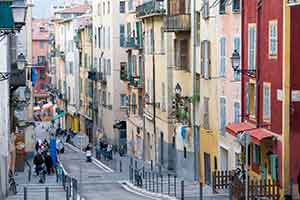 he birth of Christ, with a group called the Phoenicians, who came ultimately from Greece. They were living along the shores of the Mediterranean and were battling with the Persians, and ended up in this part of what is now the Riviera, settled already in Marseille to the west by about the 3rd or 4th century BC. This Greek culture is perhaps what gave Nice its current name because the word Nike is the Greek word for victory, which was based on one of the battles they fought to occupy the area.
he birth of Christ, with a group called the Phoenicians, who came ultimately from Greece. They were living along the shores of the Mediterranean and were battling with the Persians, and ended up in this part of what is now the Riviera, settled already in Marseille to the west by about the 3rd or 4th century BC. This Greek culture is perhaps what gave Nice its current name because the word Nike is the Greek word for victory, which was based on one of the battles they fought to occupy the area.
It was the Greeks of Antibes who first summoned the Roman Legions to their assistance in 237 B.C., and the district was very tempting to the Romans, so this first expedition was followed by others from Rome, and they soon took root, and the Romans became the dominant force. These early Greek settlers of Nice were also harassed by the native Ligurian tribes and so in 154 BC these Greeks appealed to ancient Rome to intervene and help them out. This is what brought Rome into the picture and they stayed and occupied the area for the next 500 years. The Mediterranean coast was declared a Roman province, which occurred in the reign of Augustus about 2000 years ago. By about the 4th century A.D. with the decline of the Roman Empire, Christianity became well-established and then by the early Middle Ages, the Nice area attained some commercial importance.
With the collapse of Rome, Nice shared the fortune of other towns of the northern Mediterranean coast and it was conquered by the Goths after the Romans left. Theodoric leading an army of 80,000 Visigoths brought desolation into this country. Later there were invasions by the Lombards, then Franks, and Saracens.

Throughout this historic period the Catalan culture, reaching from Spain to Italy, became firmly established, as shown by the special language shared even today throughout this region. Rulers come and go, Goths, Savoy, France, Spain, propelled by armed invasion and elite rule, but the base population remains the same – in this case a people sharing a common language and identity of Catalonia. In Spain this Catalan culture and pride remains, but France was more thorough in establishing a unified national identity, especially under the long powerful rule of Louis XIV. Today some trace of the ancient language survives among the elderly, and street signs are dual language, but the younger generations are pure French.
In 1388 Nice placed itself into the hands of the princes and dukes of Savoy, an area in the north of Italy, and from then it was a frequent victim in the contests of France with the Empire of Savoy, and the rulers of northern Italy for the possession of Provence. Like all border cities it was a bone of contention between France and Italy sometimes belonging to the Dukes of Savoy, sometimes to the Kings of France. But the sympathies of the Nicois were far more Italian than French, and most of the history of Nice is connected with the efforts made by the inhabitants to defend themselves against France.

In 1543 during the wars of Francis I and Charles V of Spain it was besieged by the French assisted by Turkish fleet and the first assault was repulsed. The Turks bombarded the castle with their cannons, but just in time, the ships of the Duke of Savoy came sailing over the blue waters and the Turks made off with all speed back to Constantinople. However, the city was eventually taken and sacked.
And then the French captured Nice again in 1600, and in 1691, and 1696. These were troubled times for the natives of Nice. And in 1705 the Duke of Berwick led a siege and the country of Nice changed masters once again.
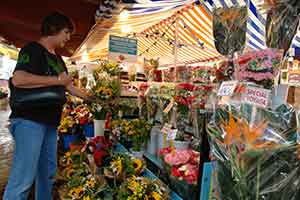
The peace of Aix-la-Chapelle restored Nice again briefly to the House of Savoy who were then the Kings of Sardinia. The French Revolution of 1789 affected Nice for a variety of reasons and ended up by making it part of France. In 1792 Nice was occupied and annexed to the French Republic, but in 1814 it reverted once again back to Sardinia, re-united to the fortunes of the House of Savoy, bringing back a strong Italian influence to the area. One important Italian connection then was the 1807 birth in Nice of Giuseppe Garibaldi, who went on to lead the battles which first unified Italy as a nation. So Nice remained Italian for close to half a century, when further political developments brought about its return to France, under Napoleon III. The treaty made on March 24th, 1860, by which the Kings of Sardinia renounced their protectorate over the town of Nice, was ratified by a popular vote of the inhabitants on June 14th, when 25,773 voted for the annexation, against 160 who opposed annexation to France and so it carried by a near-unanimous vote. In 1860 it was re-assigned by this treaty along with Savoy to France. It's been French ever since. It was a complicated, twisted historical tale.
At the same time, in 1860, construction of the railroad was completed and the beginnings of the tourism boom started. Travelers could now arrive easily from all over Europe and Nice took off as one of the great centers of tourism, given a big boost by the development of gambling in the Casino of nearby Monaco, another great destination in our visit.
CLICK HERE TO READ ABOUT THE NEXT CITY, ANTIBES

